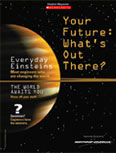  |
| >Mission: Define Your Future home | |||
| Lesson 1: Gravity on Earth Goal: Understand the concepts related to gravitational forces and flight through critical-thinking and graphing skills. Use math skills to calculate speed and forces needed for movement. Time Required: 40 minutes Directions: 2. Review Sir Isaac Newton’s theory of gravity with students and explain that gravity draws (attracts) objects to the earth. Review the following facts:
3. Distribute Gravity On Earth Student Reproducible 1 (PDF). Discuss the following example with students. If an object, such as a helicopter, had to escape the earth’s gravitational pull, it would need to generate (and sustain) an amount of lift greater than its own weight in order to take off from the ground. The more lift that is generated, the higher the helicopter will rise. The heavier the object, the greater lift force is needed. 4. In order to further illustrate the relationship between gravity and flight, discuss the following example. Explain to students that in order for a helicopter to move horizontally, it needs to generate thrust (the forward force produced by an engine) greater than the drag force (the resistance caused by the shape of an object and its movement through the air). A helicopter generates thrust by changing the propellers’ direction. For example, if the pilot directs the main rotor blades forward, the helicopter will move forward. The speed or the velocity of the helicopter depends on the amount of thrust generated. 5. As a class or in small groups, complete the worksheet. Wrap-Up: Answer Key:
Photo: © Denis Scott/Taxi/Getty Images.
|
Student Magazine Your students can meet engineers who are changing the world each day! These engineers have mastered math and science to improve the way we live. Now it's your students' turn. What will they do? Challenge them to improve the world. • Your Future: What's Out There? Find Out Now (PDF) Generously sponsored by: |
||
